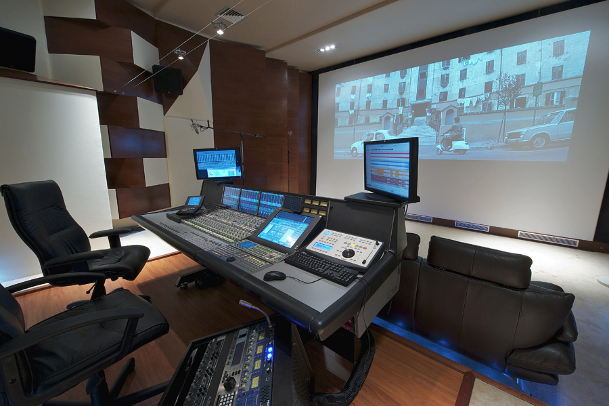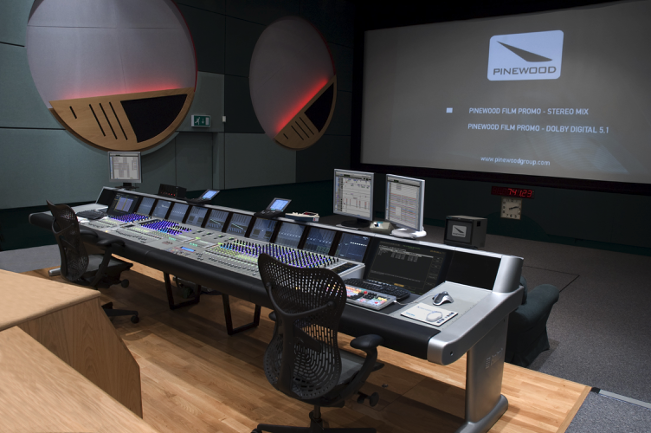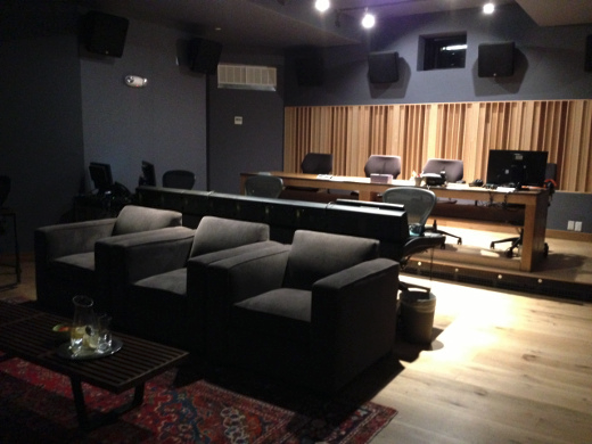Acoustic design - Film mixing studio
What is acoustic design?
Acoustic design refers to the renovation of the acoustic function of the existing space environment, including the professional combination of the space structure, suspension structure, sound insulation structure, sound absorption structure, acoustic reflection structure, acoustic diffusion structure, indoor air conditioning system, fresh air system, strong and weak current system, so as to achieve a reasonable reverberation time, sound insulation, local noise, And there should be no obvious defects such as related sound dyeing, standing wave, sound shaking, sound whistling, etc. at the same time, the sound in the environment should be clear, uniform and full, so that the final decoration effect can meet the requirements of relevant professional functions.
Now we introduce a case of acoustic design - Film mixing studio
一、Project overview and design ideas
1. Project overview
The existing empty room environment is renovated, and the professional acoustic decoration design is adopted, so that it can meet the functions of ADR dialogue recording, film DI color matching, post mixing production, video editing and so on. The whole area is divided into recording room and control room.
Control room: the room is 11.94 meters long, 6.2 meters wide, and the floor area is 74.028 square meters.
Studio: the room is 3.3 meters long and 2.3 meters wide, with a floor area of 7.59 square meters.
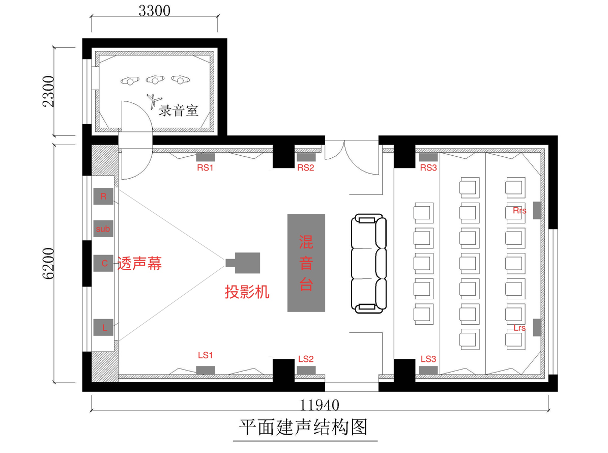
2. Design ideas
Architectural acoustic design is to understand and grasp the functional orientation of each space, and in accordance with the relevant national standards and regulations. According to the requirements of users and professional use, according to the requirements of acoustic calculation and architectural acoustic design index, the design scheme carries out scientific and complete acoustic design, so as to determine the reverberation time, eliminate the sound quality defects, obtain the sound quality effect of film and television production standard, and adapt to the requirements of recording studio function. The interior decoration materials used reach the national fire protection standard B1 level or above. And do fire prevention treatment. The environmental protection index of all materials reaches E1 level stipulated by the state.
The design fully considers the possible acoustic defects and adopts high-density sound insulation materials. When the NR value is 25 and the sound insulation capacity of the wall is 55dB, the thickness of the sound insulation wall is about 15-30cm. In addition, the top resonator design of different frequency bands will not cause common acoustic staining and degeneracy.
二、Design basis and index selection
Standard for design and measurement of architectural acoustics JGJ/T131-2000
Standard for architectural design JGJ31-2003
Standard for fire protection design of building interior decoration GB 50222-95
Environmental noise standard for urban area GB3096
Classification and test method of airborne sound insulation performance of Building Exterior Windows GB/T8485-2002
Classification and test method for air sound insulation performance of building doors GB/T16730-1997
Acoustics - Guidelines for the design of low noise workplaces - Code for noise control (GB/T 17249.1-1998EQVISO11690-1:1996)
Evaluation standard of building sound insulation GBJ121-88
Standard for measurement of building sound insulation GBJ75-84
Design standard of Dolby lab mixing recording studio
(Note: the above specifications are reference for construction)
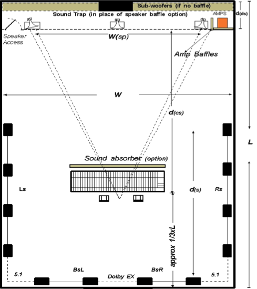
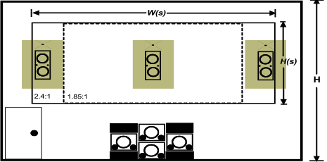
Selection of architectural acoustic design index
1. In order to achieve the allowable noise value, the walls and floors of the room are required to have enough sound insulation. We use multi-layer sound insulation wall, the door should be multi-layer sound insulation door. The recording studio should have enough clarity and intelligibility, at the same time, it should also have a certain degree of fullness. Low noise, strong sound insulation. The distribution of sound field should be uniform, and there should be no acoustic defects such as resonance, vibration echo, standing wave, acoustic focusing and dyeing.
2. Reverb time T60 design value selection:
The design standard value T60 of full frequency reverb time is selected as follows:
Frequency (Hz): 20Hz ~ 20KHz
Low frequency: 0.3 ~ 0.5
Medium: 0.4 ~ 0.6
High frequency: 0.35 ~ 0.5
Design reverb time (s) T60 ≤
3. The background noise is set as NR ~ 25
三、 Architectural acoustic design
1. Ceiling: the sound absorption area of the ceiling plays a key role in the sound absorption of the whole room. Therefore, it is very important to deal with the ceiling sound absorption in the overall acoustic design. After analysis, acoustic treatment methods are designed for the ceiling using sound insulation and sound absorption composite ceiling and resonators in different frequency bands (see the top surface figure for details).
2. Wall: strong sound absorption strong sound insulation structure, sound insulation volume up to 55dB, the choice of materials to use both aesthetic and fire protection requirements (see elevation).
3. The external door with sound insulation door. Sound insulation capacity of sound gate reaches 55dB (see structure drawing of sound insulation door for details).
4. The recording studio floor is designed with floating structure.
四、Expected Acoustic effects
Sound insulation quantity Dntw≥55 dB
Module reverb time
RT60 at 63 Hz 0.3s-0.5s
RT60 at 125 Hz 0.3s-0.5s
RT60 at 250 Hz 0.3s-0.5s
RT60 at 500 Hz 0.35s-0.55s
RT60 at 1000 Hz 0.4s-0.6s
RT60 at 2000 Hz 0.4s-0.6s
RT60 at 4000 Hz 0.4s-0.6s
RT60 at 8000 Hz 0.35s-0.5s
RT60 at 8000 Hz up 0.35s-0.5s
Indoor acoustic defects such as acoustic focus, echo and flutter echo are basically eliminated
五、The acoustic design includes the following contents:
Removal of existing wall structure;
Sound insulation wall structure installation;
Top surface sound insulation structure installation;
Laying of shock absorption and sound insulation structure on the ground;
Electric equipment pipeline laying;
Wall sound-absorbing structure installation;
Top surface sound-absorbing module installation;
Ground step structure laying;
Soundproof door production installation;
Indoor acoustic measurement and sound field validity.
六、General deployment of construction
Interior rough decoration adopts bottom-up construction flow, and fine decoration is completed from top to bottom.
The construction of audio and video system is not divided into construction sections, but in accordance with the overall construction procedure of pipeline first, then equipment installation, and finally debugging. Water and power supply are provided by water pipe network and power grid in the building.
七、Building electrical engineering
Building electrical engineering part mainly includes: low voltage distribution system, power lighting system installation
八、Water & Heating project
Water & Heating engineering mainly includes: indoor ventilation and air conditioning system noise reduction and sound insulation processing.
九、Description of decoration materials
1.The sound insulation ceiling: hanging piece +50 series of light steel keel skeleton + thickness of 50mm density of 32Kg/ cubic meters of sound absorption layer + vibration cushion + double layer 12mm thick gypsum board.
2.The sound absorption ceiling: wood keel structure +50mm density 32Kg/ cubic meter sound absorption layer + polyester fiber sound absorption board or suede fabric finish.
3.Around the light set of sound insulation wall: 75 series of light steel keel frame + vibration cushion + thickness of 50mm density of 32Kg/ cubic meters of sound absorption layer + 2X 12mm gypsum board + sealing treatment (sealant, caulking plaster).
4.The recording heavy sound insulation wall: the practice with light sound insulation wall, the process is repeated.
5.The sound absorption wall: big core board dragon skeleton (double layer 18mm thick big core board, width 100mm) +25mm density 32Kg/ cubic meter sound absorption layer +9mm thick polyester fiber surface layer or suede fabric veneer.
6.The recording studio dry floating ground, thickness of 35mm density of 80Kg/ cubic meter vibration damping layer (wooden keel frame) +1 layer of 18mm thick core board +2 layer of 12mm thick gypsum board, the ground surface layer is carpet.
7.The sound insulation door: customized steel sound insulation door, sound insulation volume of 30dB.
8.The Strong current pipe wiring: Galvanized steel PIPE JDG pipe ∮20, ∮25 wall thickness 1.2mm; Flame retardant plastic copper wire ZR-BV2.5; ZR - BV4.0
9.The lighting for 15 watt down lamp general lighting and background, wall decoration lighting.
十、Description of decoration materials
1.Must meet the design requirements, the test report to meet the requirements.
2.The decoration must be carried out after the indoor ground wall is dry.
3.The size of all kinds of sound-absorbing materials, the material section size of the keel frame, the spacing arrangement and the fixed cavity size of the wall should be strictly constructed according to the drawing.
4,The thickness and capacity of sound-absorbing glass wool have been tested and sampling inspection is required.
5.The flame retardant and sound permeable fabric, perforated plate and other cover material selection requirements are determined by the designer, if necessary, experimental measurement to determine, for the selection of grille, paint and other materials should be based on the design requirements of the sample and color sample after ordering, processing and construction.
